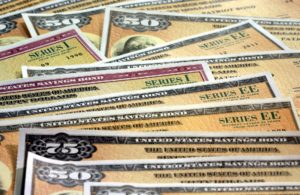Trade frictions and market volatility are on the rise. This is causing uncertainty that in turn, creates obstacles for business, consumer sentiment and spending. Recently, the Fed tightened monetary policy to a cumulative 350 basis points, or 3.5%. That is on top of the already nine interest rate hikes plus the switch to Quantitative tightening. History shows us that this level of restraint typically foreshadows the U.S.  economy heading into recession approximately 6 to 18 months later.
economy heading into recession approximately 6 to 18 months later.
Then consider that we are in one of the most overleveraged peace time economies on record, particularly for the ‘debt time bomb‘ sitting on corporate balance sheets. So what’s an investor to do?
In in our current economic situation, many investors are looking to get their hands on the safest assets available, such as bonds. In fact, the amount of bonds with negative yields—that is, getting back less than what was paid if the debt was held to maturity—has ballooned. In this monetary policy shift, investors are actually anticipating a global decrease in interest rates, along with looser financial conditions. There’s no better time to take advantage of them.
A Bond Breakdown
Simply put, a bond is a loan issued by federal and local governments or corporations when they need funding that they don’t have. When you purchase a bond, you essentially become a lender. The bond issuer pays back the lender by the bond’s end date, known as the maturity date, in addition to interest paid during the life of the bond. Bond maturity can be just a few days to a few decades.
 Interest amount, referred to as the coupon, and timing also vary. Some bonds pay interest twice a year, while zero-coupon bonds pay all interest on the bond’s maturity date.
Interest amount, referred to as the coupon, and timing also vary. Some bonds pay interest twice a year, while zero-coupon bonds pay all interest on the bond’s maturity date.
There are three type of bonds to consider: municipal, treasury and corporate. Municipal bonds are issued by local municipalities. You can purchase bonds in or outside your own local community. The bonus of these bonds is that if you purchase in your own community, you often have the opportunity to see and use the projects that the bonds are used for, like street resurfacing or a new park.
While this bond usually pays a lower interest rate, the interest is exempt from federal taxes and if you bought within your community, it’s also exempt from state and local taxes.
Treasury bonds, or T-bonds, are used by the federal government and usually set to mature at 10 years. You don’t pay local or state taxes on them, but you are responsible for federal taxes. Interest rates are similar to those of municipal bonds.
The highest interest rate bond, and thus the highest risk, is a corporate bond. Corporate bonds are issued by companies to fund specific projects. Corporate bonds are taxable at all levels.
Pros and Cons of Investing in Bonds
Bonds are an excellent addition to your portfolio for four key reasons:
- Because bonds are low risk, they work to balance high-risk investments, such as stocks, in a diversified financial portfolio. And because
 governments and corporations are not likely to default on their loans, bonds are pretty safe investments.
governments and corporations are not likely to default on their loans, bonds are pretty safe investments. - If you buy bonds that make periodic interest payments (usually biannually), the bonds then become a stream of steady income.
- Bonds are easy to purchase and manage, no financial advisor needed. Though you can absolutely enlist the help of an advisor to sell bonds before their maturity date to make a profit.
- Bonds can yield more than just interest payments. If you purchase local municipal bonds or T-bonds, you can feel as though you are helping to improve the community you live in. If you purchase corporate bonds, you can support companies that you want to thrive.
While the benefits of bonds are clear, they aren’t for every investor. Although bonds are low risk, there is still some risk in involved. First, the bond issuer can default, thus you could lose your investment, your interest, or both. One way to lower this risk is to invest in bond funds – a range of bond investments in one package. That way if one bond defaults, you still have the others.
Secondly, there is interest rate risk. If interest rates rise, bond prices (and value) could drop since investors can then earn higher interest rates elsewhere. The lower the interest rate, the easier the bond is to sell if the interest rate paid is higher than the market rate.
Then there is inflation. The interest from the bond must keep up with inflation, otherwise you may actually lose money as the value of your investment goes down.
If you need access to your assets, bonds may not be right for you. An investment in a bond is usually a long-term investment through to the maturity date.
You may want to avoid bonds if you are looking for higher risk investments that yield higher returns. CNN Money reports that government bonds yield about half the annual return of large stocks.
Navigating Bonds
While some of the appeal of adding bonds to your portfolio is the easy do-it-yourself mentality, but so is painting your house. Experience matters when purchasing and laddering a bond portfolio. You can purchase government bonds, but even then, it’s tough to know if the interest rate is decent and if the bond is strong. You also need to do your research to assess the bond’s credit quality and duration.
Stableford’s experience with the different types of bonds and how they best complement your existing investments, creating a low volatile, diversified portfolio will help you plan for the future. To learn more about bond investing or to purchase bonds, contact us at 480.493.2300.
